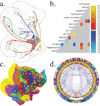Imaging human connectomes at the macroscale
- PMID: 23722212
- PMCID: PMC4096321
- DOI: 10.1038/nmeth.2482
Imaging human connectomes at the macroscale
Abstract
At macroscopic scales, the human connectome comprises anatomically distinct brain areas, the structural pathways connecting them and their functional interactions. Annotation of phenotypic associations with variation in the connectome and cataloging of neurophenotypes promise to transform our understanding of the human brain. In this Review, we provide a survey of magnetic resonance imaging–based measurements of functional and structural connectivity. We highlight emerging areas of development and inquiry and emphasize the importance of integrating structural and functional perspectives on brain architecture.
Figures



References
-
- Varela F, Lachaux JP, Rodriguez E, Martinerie J. The brainweb: phase synchronization and large-scale integration. Nat. Rev. Neurosci. 2001;2:229–239. - PubMed
Publication types
MeSH terms
Grants and funding
LinkOut - more resources
Full Text Sources
Other Literature Sources
Medical

